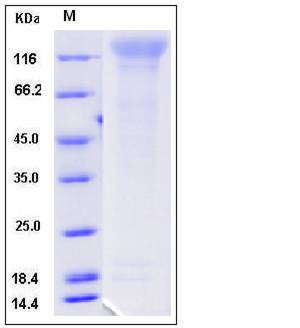Mouse CD96 Protein (His Tag)
1700109I12Rik,Tactile
- 100ug (NPP3250) Please inquiry
| Catalog Number | P50758-M08H |
|---|---|
| Organism Species | Mouse |
| Host | Human Cells |
| Synonyms | 1700109I12Rik,Tactile |
| Molecular Weight | The secreted recombinant mouse CD96 comprises 526 amino acids and has a calculated molecular mass of 58 kDa. As a result of glycosylation, the apparent molecular mass of the recombinant protein is approximately 130-140 kDa in SDS-PAGE under reducing conditions. |
| predicted N | Val 22 |
| SDS-PAGE |  |
| Purity | > 90 % as determined by SDS-PAGE |
| Protein Construction | A DNA sequence encoding the mouse CD96 (Q3U0X8) extracellular domain (Met 1-Met 536) was expressed, fused with a C-terminal polyhistidine tag. |
| Bio-activity | 1. Measured by its binding ability in a functional ELISA. 2. Immobilized recombinant Mouse CD96 at 10 μg/ml (100 μl/well) can bind mouse PVR with a linear range of 6.4-160 ng/ml. |
| Research Area | Immunology |Innate Immunity |Monocytes/Macrophages |Co-stimulatory Molecules |
| Formulation | Lyophilized from sterile PBS, pH 7.4 1. Normally 5 % - 8 % trehalose and mannitol are added as protectants before lyophilization. Specific concentrations are included in the hardcopy of COA. |
| Background | The cluster of differentiation (CD) system is commonly used as cell markers in immunophynotyping. Different kinds of cells in the immune system can be identified through the surface CD molecules which associating with the immune function of the cell. There are more than 320 CD unique clusters and subclusters have been identified. Some of the CD molecules serve as receptors or ligands important to the cell through initiating a signal cascade which then alter the behavior of the cell. Some CD proteins do not take part in cell signal process but have other functions such as cell adhesion. The CD155 ligand CD96 is a member of the Ig superfamily. It's a immunoglobulin-like protein tentatively allocated to the repertoire of human NK receptors. NK cells recognize poliovirus receptor (PVR), a nectins and nectin-like protein family member serve to mediate cell-cell adhesion, cell migration, with the presence of an additional receptor, CD96. CD96 promotes NK cell adhesion to target cells expressing PVR, stimulates cytotoxicity of activated NK cells, and mediates acquisition of PVR from target cells. The effect the cells with mutated CD96 protein lost adhesion and growth activities indicates that CD96 mutations may cause a form of the C syndrome by interfering with cell adhesion and growth. |
| Reference |
